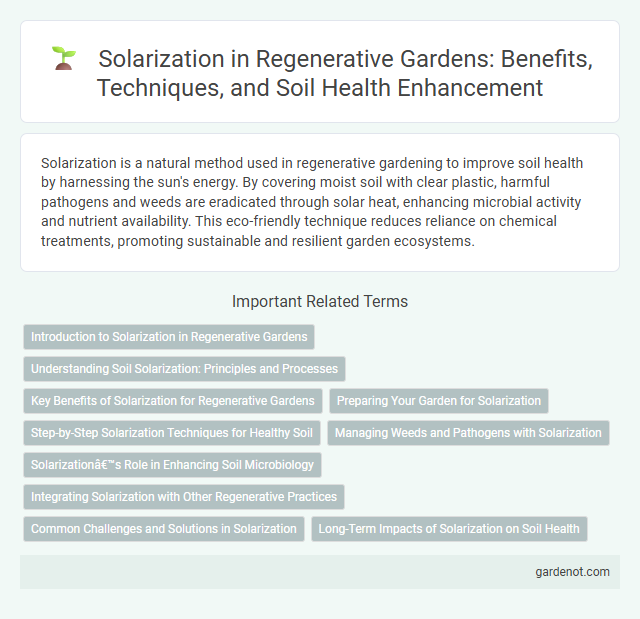Solarization is a natural method used in regenerative gardening to improve soil health by harnessing the sun's energy. By covering moist soil with clear plastic, harmful pathogens and weeds are eradicated through solar heat, enhancing microbial activity and nutrient availability. This eco-friendly technique reduces reliance on chemical treatments, promoting sustainable and resilient garden ecosystems.
Introduction to Solarization in Regenerative Gardens
Solarization in regenerative gardens utilizes solar energy to naturally sterilize soil, reducing pests, pathogens, and weed seeds through high-temperature exposure. Transparent plastic sheets trap solar heat, increasing soil temperature to levels that inhibit harmful organisms while preserving beneficial microorganisms. This eco-friendly technique enhances soil health and promotes sustainable crop production without chemical inputs.
Understanding Soil Solarization: Principles and Processes
Soil solarization is an environmentally friendly method that uses solar energy to increase soil temperature, effectively controlling soil-borne pests, pathogens, and weed seeds. This process involves covering moist soil with transparent polyethylene sheets during warm months, allowing solar radiation to heat the soil to temperatures lethal for harmful organisms. By naturally sterilizing the soil, solarization enhances soil health and supports sustainable practices in regenerative gardening.
Key Benefits of Solarization for Regenerative Gardens
Solarization enhances soil health in regenerative gardens by using solar energy to naturally eliminate soil-borne pathogens, weeds, and pests, reducing the need for chemical treatments. This process boosts microbial activity and nutrient availability, promoting robust plant growth and improving overall soil fertility. Solarization also conserves water and supports sustainable ecosystem balance by enhancing organic matter decomposition and soil structure.
Preparing Your Garden for Solarization
Clear the garden area of all debris, weeds, and plant residues to enhance solar heat penetration and ensure effective soil sterilization. Moisten the soil deeply before covering it with transparent polyethylene plastic to trap solar energy and increase soil temperature. Secure the plastic edges tightly to prevent heat loss and maximize sterilization efficiency over the recommended 4-6 week solarization period.
Step-by-Step Solarization Techniques for Healthy Soil
Solarization involves covering moist soil with clear plastic to trap solar energy, raising soil temperatures to 110-125degF (43-52degC) for 4-6 weeks, effectively eliminating soil-borne pathogens, weeds, and pests. Begin by thoroughly watering the soil, then smooth and level the surface before tightly sealing the edges of the plastic to maximize heat retention. This environmentally friendly method enhances soil health by promoting beneficial microorganisms and nutrient availability in regenerative gardening.
Managing Weeds and Pathogens with Solarization
Solarization uses solar energy to heat the soil, effectively reducing weed seeds and soil-borne pathogens without chemicals. This method involves covering moist soil with clear plastic during hot months, raising temperatures to levels that inhibit or kill harmful organisms. Maintaining proper moisture and exposure time enhances pathogen control, promoting healthier plant growth in regenerative gardens.
Solarization’s Role in Enhancing Soil Microbiology
Solarization uses solar heat to elevate soil temperature, effectively suppressing harmful pathogens while promoting beneficial microbial populations critical for nutrient cycling. This process increases microbial diversity and activity, enhancing soil fertility and structure in regenerative garden systems. Improved microbial communities foster robust plant growth by facilitating nutrient availability and disease resistance.
Integrating Solarization with Other Regenerative Practices
Integrating solarization with composting and cover cropping enhances soil pest control and nutrient cycling, promoting healthier plant growth. Solarization effectively reduces soilborne pathogens while cover crops improve soil structure and organic matter, creating a synergistic environment for regeneration. This combined approach minimizes chemical inputs and supports sustainable garden ecosystems.
Common Challenges and Solutions in Solarization
Solarization faces common challenges such as uneven soil heating, pest resistance, and the time required for effective treatment, typically 4 to 6 weeks under strong sunlight. Solutions involve using clear plastic sheets for better heat retention, ensuring soil moisture to enhance thermal conductivity, and combining solarization with organic amendments to improve pest and pathogen control. Optimizing these factors boosts soil disinfection efficiency and supports healthier, regenerative garden ecosystems.
Long-Term Impacts of Solarization on Soil Health
Solarization significantly enhances soil health by reducing soil-borne pathogens, enhancing beneficial microbial populations, and increasing nutrient availability for extended periods. Over time, this process promotes improved soil structure, moisture retention, and organic matter decomposition, contributing to sustained fertility in regenerative gardens. Long-term implementation of solarization supports resilient ecosystems and boosts crop productivity by maintaining balanced soil ecosystems.
Solarization Infographic

 gardenot.com
gardenot.com